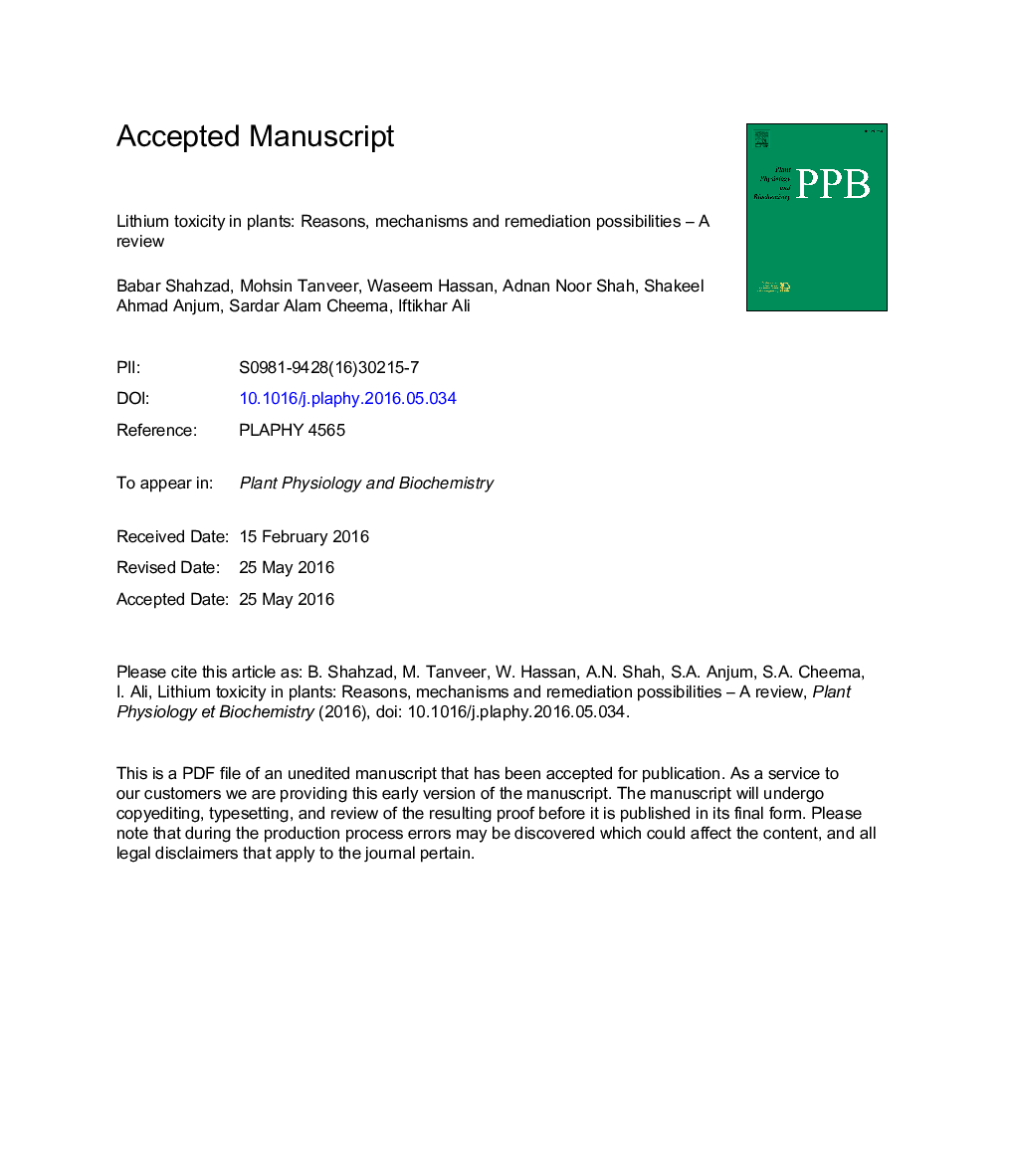| کد مقاله | کد نشریه | سال انتشار | مقاله انگلیسی | نسخه تمام متن |
|---|---|---|---|---|
| 2014656 | 1541914 | 2016 | 38 صفحه PDF | دانلود رایگان |
عنوان انگلیسی مقاله ISI
Lithium toxicity in plants: Reasons, mechanisms and remediation possibilities - A review
ترجمه فارسی عنوان
سمیت لیتیوم در گیاهان: دلایل، مکانیزم ها و امکان احیاء - بررسی
دانلود مقاله + سفارش ترجمه
دانلود مقاله ISI انگلیسی
رایگان برای ایرانیان
کلمات کلیدی
لیتیم، اثرات و تحرک، رشد گیاه، فیزیولوژی، دیدگاه های پژوهشی،
ترجمه چکیده
لیتیوم (لی) یک عنصر طبیعی است. با این حال، یکی از فلزات غیر ضروری برای زندگی است. لیتیوم در حال تبدیل شدن به موضوع جدی بحث برای افرادی که تحقیقات در مورد فلزات ردیابی و مسمومیت زیست محیطی در گیاهان است. با توجه به اطلاعات محدود موجود در مورد تحرک آن از خاک به گیاهان، اثرات نامطلوب سمیت لی به گیاهان هنوز مشخص نیست. این مقاله به طور خلاصه مسائل مربوط به لی، نقش آن و ضروری بودن آن در گیاهان و مسیرهای تحقیقاتی که ممکن است در مطالعات بین رشته ای برای ارزیابی اهمیت سمیت لی مورد استفاده قرار گیرد، مورد بحث قرار می گیرد. علاوه بر این، روشهای بازپرداخت بالقوه نیز در این بررسی برجسته خواهد شد. به طور خلاصه، لی رشد گیاهان را در هر دو روش تحریک و کاهش، بسته به غلظت لی در محیط رشد، تحت تاثیر قرار داد. در سمت منفی، لی باعث کاهش رشد گیاه توسط قطع کردن فرایندهای فیزیولوژیکی متعدد و تغییر متابولیسم در گیاه می شود. آلودگی خاک توسط لی تبدیل به یک مشکل جدی است، که ممکن است تهدیدی برای تولید محصول در آینده نزدیک باشد. علاوه بر این، فقدان اطلاعات قابل توجهی در مورد مکانیسم های تحمل گیاهان بیشتر وضعیت را تشدید می کند. بنابراین، تحقیقات آینده باید در یافتن راه حل های برجسته و قابل دسترس برای به حداقل رساندن ورودی لی از منابع آن (به ویژه از باتری های لیتیک) به خاک و زنجیره غذایی تاکید داشته باشند.
موضوعات مرتبط
علوم زیستی و بیوفناوری
علوم کشاورزی و بیولوژیک
دانش گیاه شناسی
چکیده انگلیسی
Lithium (Li) is a naturally occurring element; however, it is one of the non-essential metals for life. Lithium is becoming a serious matter of discussion for the people who do research on trace metals and environmental toxicity in plants. Due to limited information available regarding its mobility from soil to plants, the adverse effects of Li toxicity to plants are still unclear. This article briefly discusses issues around Li, its role and its essentiality in plants and research directions that may assist in inter-disciplinary studies to evaluate the importance of Li's toxicity. Further, potential remediation approaches will also be highlighted in this review. Briefly, Li influenced the growth of plants in both stimulation and reduction ways, depending on the concentration of Li in growth medium. On the negative side, Li reduces the plant growth by interrupting numerous physiological processes and altering metabolism in plant. The contamination of soil by Li is becoming a serious problem, which might be a threat for crop production in the near future. Additionally, lack of considerable information about the tolerance mechanisms of plants further intensifies the situation. Therefore, future research should emphasize in finding prominent and approachable solutions to minimize the entry of Li from its sources (especially from Li batteries) into the soil and food chain.
ناشر
Database: Elsevier - ScienceDirect (ساینس دایرکت)
Journal: Plant Physiology and Biochemistry - Volume 107, October 2016, Pages 104-115
Journal: Plant Physiology and Biochemistry - Volume 107, October 2016, Pages 104-115
نویسندگان
Babar Shahzad, Mohsin Tanveer, Waseem Hassan, Adnan Noor Shah, Shakeel Ahmad Anjum, Sardar Alam Cheema, Iftikhar Ali,
